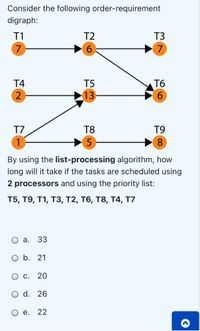
Database System Concepts
7th Edition
ISBN: 9780078022159
Author: Abraham Silberschatz Professor, Henry F. Korth, S. Sudarshan
Publisher: McGraw-Hill Education
expand_more
expand_more
format_list_bulleted
Concept explainers
Question

Transcribed Image Text:Consider the following order-requirement
digraph:
T1
T2
T3
7.
6
7
T4
T5
T6
6.
2
13
T7
T8
T9
5
8.
By using the list-processing algorithm, how
long will it take if the tasks are scheduled using
2 processors and using the priority list:
Т5, T9, T1, тз, т2, Т6, т8, Т4, T7
О а. 33
O b. 21
О с. 20
O d. 26
Ое. 22
Expert Solution
This question has been solved!
Explore an expertly crafted, step-by-step solution for a thorough understanding of key concepts.
This is a popular solution
Trending nowThis is a popular solution!
Step by stepSolved in 2 steps

Knowledge Booster
Learn more about
Need a deep-dive on the concept behind this application? Look no further. Learn more about this topic, computer-science and related others by exploring similar questions and additional content below.Similar questions
- Evaluate the postfix expressions by using the algorithm in the book. You MUST show the steps to get full credit. Postfix expression: 28-62/- Step# Expression 1 2 3 لیا 4 6 28 - 6 2 / 7 8 5 2 1 6 2 / 62/ 6 2/ End of expression (Answer) Status of the Operand Stack Top = -1 Calculationarrow_forward1. Execute the foiiowing instructions by hand, then find the final centents of X, Y and memory locati $C159 to $C159. Moving a Block of Memory from One Location to Ancther Algorithm Description In this prograH, we want to move the contents of block 1 ($CI00 to $CIO7) to block 2 ($C150 to'? This means that the contents of $C100 (44H) will move to the contents of $C150 and overwrite them and so on. After executing the program, the contents of the two blocks should be same. Remember, when we write any new data over existing data, the latter will be lost and replaced by the new data. MOve.aSm STARTI · EQU $C100 EQU $CI.07 EQU $C150 : END START2 ORG $CO00 #STARTI #START2 ;x points to 1st byte in block 1 :Y points to 1st byte in block 2 ;get data from blockl ;stoře ít in block2 ;incremerit 1st poi.nter ¡increment 2nd pointer ;reached bottom of the b • LDX LDY AGATN LDAA 0,X STAA 0,Y Memory Cido INX - INY CPX #END AGALN ;no, branch 05 37 57 67 BNE END A ¡yes, stop CI04arrow_forwardThe stack is the most frequent arrangement for the central processing unit (CPU) of a computer, but the other two topologies are also possible.arrow_forward
- Write the four situations under which CPU scheduling decisions takes placearrow_forwardA program is made up of 10 10 instructions, with 70% of the instructions being ALU instructions, 20% being load instructions, and 10% being jump instructions. The load instructions' resultant values are utilized in half of the instructions that follow the loads. The ID stage is where jumps are decided. What is the CPI's effective value?arrow_forwardParallel processing allows a computer to simultaneously work on subparts of a problem. Select one: True Falsearrow_forward
- How about you compare and contrast the different CPU Scheduling Algorithms (article)?arrow_forwardThere are a few different configurations that might be used for the central processing unit (CPU) of a computer. The general register, a single accumulator, or a stack are the three possibilities. There are positives and negatives associated with each option individually. It is up to you to provide a response, and the response that you provide might be accurate or it could be erroneous.arrow_forwardIn this implementation, each instruction is provided with its own data independently of how other instructions acquire theirs. We insert a(n): A Multiple Input/Output B The Case of Many Pieces of Information or Directions C Unique Information Only One D Several Insts From Onearrow_forward
- Overclocking's pros and cons are explained. Processor Overclocking Pros and Cons Please answer every question.arrow_forwardA computer's central processing unit (CPU) may be set up in one of three different ways: as a generic register, a single accumulator, or a stack. You must respond, and whether your response is accurate is up to you.arrow_forward
arrow_back_ios
arrow_forward_ios
Recommended textbooks for you
 Database System ConceptsComputer ScienceISBN:9780078022159Author:Abraham Silberschatz Professor, Henry F. Korth, S. SudarshanPublisher:McGraw-Hill Education
Database System ConceptsComputer ScienceISBN:9780078022159Author:Abraham Silberschatz Professor, Henry F. Korth, S. SudarshanPublisher:McGraw-Hill Education Starting Out with Python (4th Edition)Computer ScienceISBN:9780134444321Author:Tony GaddisPublisher:PEARSON
Starting Out with Python (4th Edition)Computer ScienceISBN:9780134444321Author:Tony GaddisPublisher:PEARSON Digital Fundamentals (11th Edition)Computer ScienceISBN:9780132737968Author:Thomas L. FloydPublisher:PEARSON
Digital Fundamentals (11th Edition)Computer ScienceISBN:9780132737968Author:Thomas L. FloydPublisher:PEARSON C How to Program (8th Edition)Computer ScienceISBN:9780133976892Author:Paul J. Deitel, Harvey DeitelPublisher:PEARSON
C How to Program (8th Edition)Computer ScienceISBN:9780133976892Author:Paul J. Deitel, Harvey DeitelPublisher:PEARSON Database Systems: Design, Implementation, & Manag...Computer ScienceISBN:9781337627900Author:Carlos Coronel, Steven MorrisPublisher:Cengage Learning
Database Systems: Design, Implementation, & Manag...Computer ScienceISBN:9781337627900Author:Carlos Coronel, Steven MorrisPublisher:Cengage Learning Programmable Logic ControllersComputer ScienceISBN:9780073373843Author:Frank D. PetruzellaPublisher:McGraw-Hill Education
Programmable Logic ControllersComputer ScienceISBN:9780073373843Author:Frank D. PetruzellaPublisher:McGraw-Hill Education

Database System Concepts
Computer Science
ISBN:9780078022159
Author:Abraham Silberschatz Professor, Henry F. Korth, S. Sudarshan
Publisher:McGraw-Hill Education

Starting Out with Python (4th Edition)
Computer Science
ISBN:9780134444321
Author:Tony Gaddis
Publisher:PEARSON

Digital Fundamentals (11th Edition)
Computer Science
ISBN:9780132737968
Author:Thomas L. Floyd
Publisher:PEARSON

C How to Program (8th Edition)
Computer Science
ISBN:9780133976892
Author:Paul J. Deitel, Harvey Deitel
Publisher:PEARSON

Database Systems: Design, Implementation, & Manag...
Computer Science
ISBN:9781337627900
Author:Carlos Coronel, Steven Morris
Publisher:Cengage Learning

Programmable Logic Controllers
Computer Science
ISBN:9780073373843
Author:Frank D. Petruzella
Publisher:McGraw-Hill Education